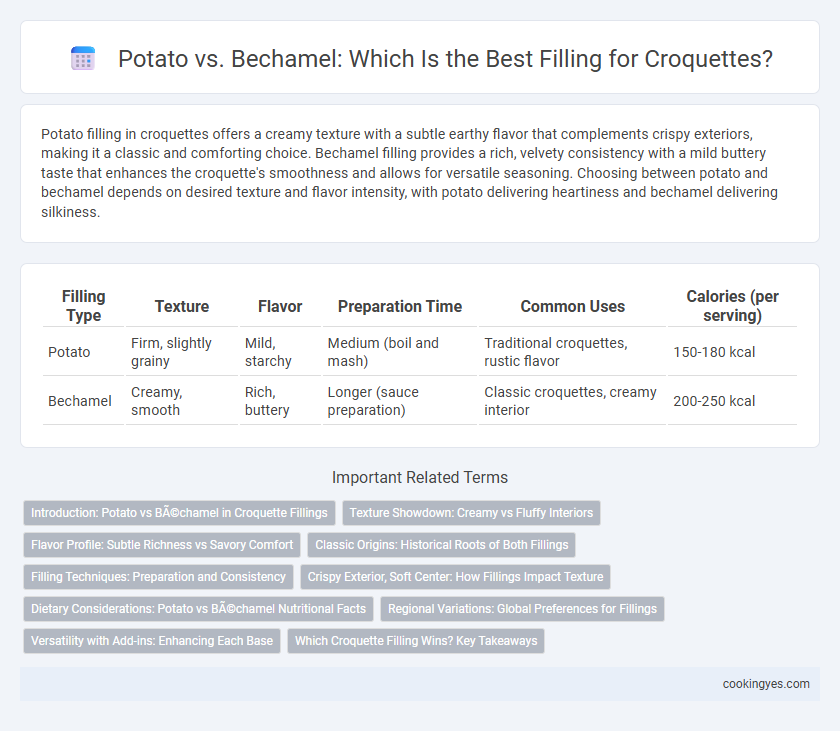Potato filling in croquettes offers a creamy texture with a subtle earthy flavor that complements crispy exteriors, making it a classic and comforting choice. Bechamel filling provides a rich, velvety consistency with a mild buttery taste that enhances the croquette's smoothness and allows for versatile seasoning. Choosing between potato and bechamel depends on desired texture and flavor intensity, with potato delivering heartiness and bechamel delivering silkiness.
Table of Comparison
| Filling Type | Texture | Flavor | Preparation Time | Common Uses | Calories (per serving) |
|---|---|---|---|---|---|
| Potato | Firm, slightly grainy | Mild, starchy | Medium (boil and mash) | Traditional croquettes, rustic flavor | 150-180 kcal |
| Bechamel | Creamy, smooth | Rich, buttery | Longer (sauce preparation) | Classic croquettes, creamy interior | 200-250 kcal |
Introduction: Potato vs Béchamel in Croquette Fillings
Potato and bechamel are the two primary fillings used in croquettes, each offering distinct textures and flavors. Potato croquettes provide a denser, more rustic bite with a naturally earthy taste, while bechamel-based fillings yield a creamier, smoother interior due to the rich combination of butter, flour, and milk. The choice between potato and bechamel fundamentally influences the croquette's moisture content, mouthfeel, and overall richness, catering to different culinary preferences and regional variations.
Texture Showdown: Creamy vs Fluffy Interiors
Potato-based croquettes deliver a fluffy, slightly grainy texture that provides a satisfying bite, while bechamel fillings boast a velvety creaminess that melts smoothly in the mouth. The starchiness of potatoes creates a drier, more porous interior, enhancing crispness on the outside, whereas bechamel offers a rich, dense softness that contrasts with the crunchy coating. Choosing between potato and bechamel filling impacts the croquette's overall mouthfeel, balancing fluffy lightness against indulgent creaminess.
Flavor Profile: Subtle Richness vs Savory Comfort
Potato croquette fillings deliver a subtle richness with their creamy texture and mild, naturally earthy flavor, providing a light base that highlights the golden, crispy exterior. Bechamel-based fillings offer a savory comfort through a smooth, velvety sauce infused with butter and nutmeg, creating a luscious and indulgent taste experience. Selecting between potato or bechamel impacts the overall flavor profile, balancing understated warmth against rich, savory depth.
Classic Origins: Historical Roots of Both Fillings
The classic croquette fillings of potato and bechamel each trace back to rich culinary traditions in European cuisine, with potato croquettes originating in 18th-century France as a means to repurpose leftover mashed potatoes. Bechamel-based croquettes, rooted in French haute cuisine, evolved from the delicate white sauce introduced by 17th-century chefs, showcasing a sophisticated, creamy texture. Both fillings reflect historical adaptations where regional ingredients and cooking techniques shaped the distinctive character of croquettes across Europe.
Filling Techniques: Preparation and Consistency
Potato croquette fillings require mashing boiled potatoes until smooth and mixing them with butter, seasoning, and sometimes eggs to achieve a creamy yet firm consistency that holds shape during frying. Bechamel-based fillings demand careful preparation of a thick white sauce made from butter, flour, and milk, cooked until dense enough to coat the back of a spoon, ensuring a rich and velvety texture. Both fillings must cool thoroughly before shaping to maintain structural integrity and prevent disintegration when breaded and fried.
Crispy Exterior, Soft Center: How Fillings Impact Texture
Potato filling in croquettes creates a fluffy, creamy interior that contrasts perfectly with a golden, crispy exterior, enhancing the classic texture experience. Bechamel filling offers a richer, silkier center that maintains softness while providing a slightly denser mouthfeel, allowing the crispy crust to stand out more prominently. The choice between potato and bechamel fillings directly influences the croquette's balance of crunch and creaminess, shaping its overall sensory appeal.
Dietary Considerations: Potato vs Béchamel Nutritional Facts
Potato croquette fillings offer a lower-calorie and gluten-free option with high fiber content, making them suitable for those seeking a lighter or allergen-friendly choice. Bechamel-based croquettes tend to be richer in fat and calories due to butter, milk, and flour, which also increases carbohydrate and protein content but may pose challenges for lactose-intolerant individuals. Nutritional facts highlight potatoes as a source of vitamin C and potassium, whereas bechamel contributes calcium and additional saturated fat, affecting dietary planning depending on individual health goals.
Regional Variations: Global Preferences for Fillings
Potato-filled croquettes dominate in regions like Spain and Latin America, where the starchy texture complements local ingredients such as ham or cheese. In contrast, bechamel-based croquettes are favored in France and parts of Italy, prized for their creamy, rich consistency that pairs well with seafood or mushrooms. These regional preferences highlight diverse culinary traditions and ingredient availability shaping croquette fillings worldwide.
Versatility with Add-ins: Enhancing Each Base
Potato-based croquette fillings offer a firm texture that easily absorbs bold add-ins like herbs, cheese, and spices, making them ideal for customized savory variations. Bechamel-based fillings provide a creamy, smooth consistency that blends seamlessly with delicate ingredients such as seafood, mushrooms, or finely chopped vegetables, enhancing the croquette's richness without overpowering the main flavors. The choice between potato and bechamel bases significantly impacts the croquette's flavor profile and texture, allowing cooks to tailor fillings from rustic and hearty to silky and refined.
Which Croquette Filling Wins? Key Takeaways
Potato croquettes offer a hearty, rustic texture with a naturally creamy interior, making them a traditional favorite in many cultures. Bechamel-based croquettes provide a smooth, velvety filling that balances richness with versatility, often preferred for gourmet or delicate flavors. Choosing the winning croquette filling depends on desired texture and taste profile, with potato excelling in comfort and bechamel shining in refined applications.
Potato vs Béchamel for croquette filling Infographic

 cookingyes.com
cookingyes.com